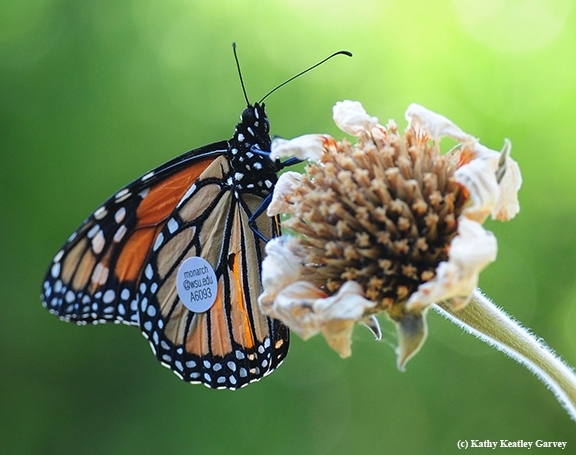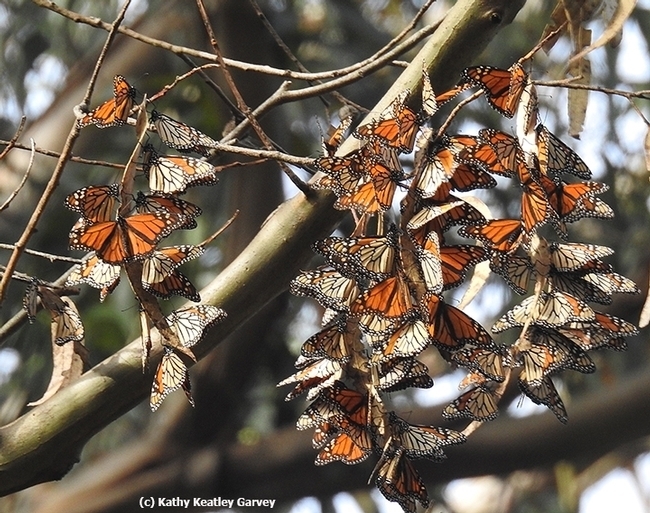- Author: Kathy Keatley Garvey

The Celebration of Life and Legacy of UC Cooperative Extension apiculturist emeritus Eric Mussen, held Aug. 28 in the Putah Creek Lodge, UC Davis, drew a standing-room only crowd who shared and applauded the many facets of his life: family man, bee scientist, athlete, angler, birder, photographer, humorist and a singer (doo wop).
They all remembered that engaging smile, a smile that could melt frozen ice cream (a dessert he loved).
Members of California's beekeeping and almond industries--Team Eric--came out in force to honor their hero, their mentor, their confidant, their friend. Some traveled from as far away as Washington state and Idaho.
UC Davis distinguished professor Walter Leal live-streamed the event and posted it today on YouTube at https://youtu.be/Kj5NuQ_rBuo.
Dr. Mussen, who preferred to be called "Eric," was an internationally known 38-year Extension apiculturist and an invaluable member of the UC Davis Department of Entomology and Nematology faculty since 1976. He died Friday, June 3 in his Davis home at age 78 from aggressive liver cancer.
Although Eric retired in 2014, he continued his many activities until a few weeks prior to his death. For nearly four decades, he drew praise as “the honey bee guru,” “the pulse of the bee industry" and as "the go-to person" when consumers, scientists, researchers, students, and the news media sought answers about honey bees. Colleagues described him as the “premier authority on bees and pollination in California, and one of the top beekeeping authorities nationwide,” “a treasure to the beekeeping industry," and "a walking encyclopedia when it comes to honey bees.” Among who sought his expertise: The Lehrer Hour, BBC, Good Morning America, National Public Radio (Science Friday), The New York Times, Boston Globe, and The Los Angeles Times.
The Aug. 28th celebration opened with a welcome by Steve Nadler, professor and chair of the UC Davis Department of Entomology, who introduced Chancellor Gary May.
"Eric was a cherished friend to everyone here, to the UC Davis community, to his colleagues, to scientists and researchers, to agricultural growers and 4-H-ers, and to beekeepers and bee enthusiasts everywhere," the chancellor told the crowd. "He meant so much to the university and his work benefited us all. He represented the absolute best of UC Davis. He was an internationally recognized expert, dedicated to his work, and passionate about helping others and making the world a better place to be. His legacy will endure. It will endure through his research contributions and extension activities that served beekeeping operations across California and the nation. It will endure through the practices he helped put in place, sharing information with beekeeping groups. It will endure through the next generation of apiculturists he helped inspire. We'll remember his impact as the 'honey bee guru.' Much more than that, Eric will be remembered for his generosity, his kindness and his passion."
Emcee Gene Brandi, an icon in the bee industry and a family friend, served with Eric for 37 of his 39 years on the California State Beekeeping Association's Board of Directors. He currently chairs the Foundation for the Preservation of Honey Bees, Inc., and also served as president of American Beekeeping Federation and chaired both the California Apiary Board and National Honey Board.
One of Gene's many memorable comments: “To paraphrase a good friend of mine, (beekeeper) John Miller, “The people who really make a difference in this life are those who make things better. Eric Mussen made things better for the honey bee, beekeepers and the entire beekeeping industry and for that we are very grateful.”
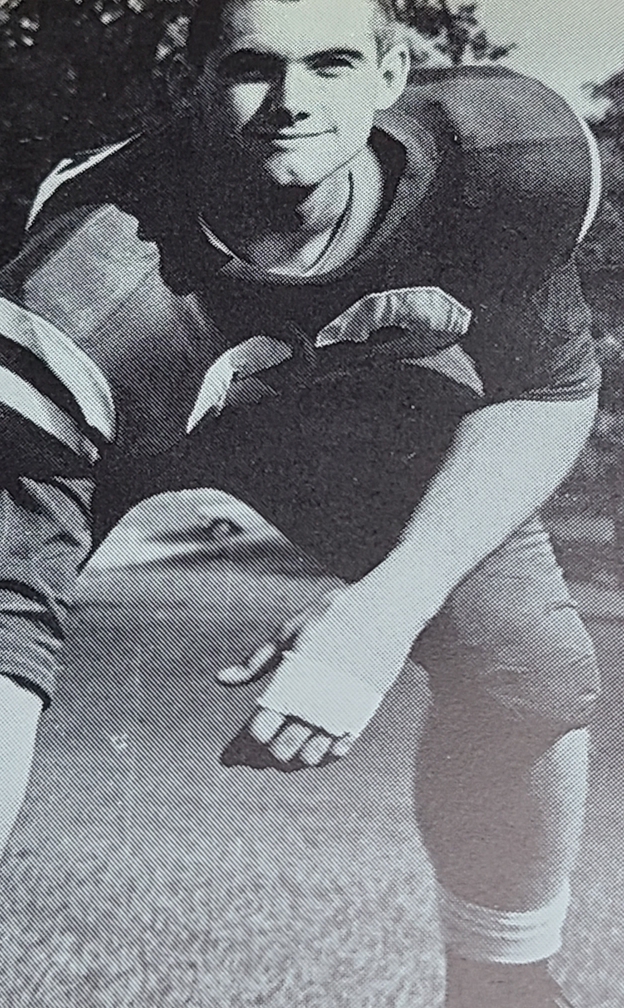
There were scores of memorable comments from the speakers:
- Robert “Bob” Curtis, Carmichael, former director of Agricultural Affairs, Almond Board of California
- Ettamarie Peterson, veteran 4-H beekeeping project leader of the Liberty 4-H Club, Petaluma, a past president of the Sonoma County Beekeepers' Association, and a close friend of Eric's.
- Glenda Humiston, vice president of the UC Agriculture and Natural Resources, and Helene Dillard, dean of the UC Davis College of Agricultural and Environmental Sciences (virtual eulogies)
- Elina Lastro Niño, UC Extension apiculturist who also read the text of UC Davis emeritus professor Norman Gary, who was unable to attend
- Diane Ullman, professor and former chair of the Department of Entomology and Nematology
- Mary Lou Flint, an emeritis associate director of the UC Statewide Integrated Pest Management (UC IPM) Program, and an emeritus Extension entomologist, Department of Entomology and Nematology
- Walter Leal, UC Davis distinguished professor and former chair of the then Department of Entomology
- Michael Parrella, dean of the College of Agricultural and Life Sciences, University of Idaho, and a former chair of the Department of Entomology and Nematology
- And so many more...
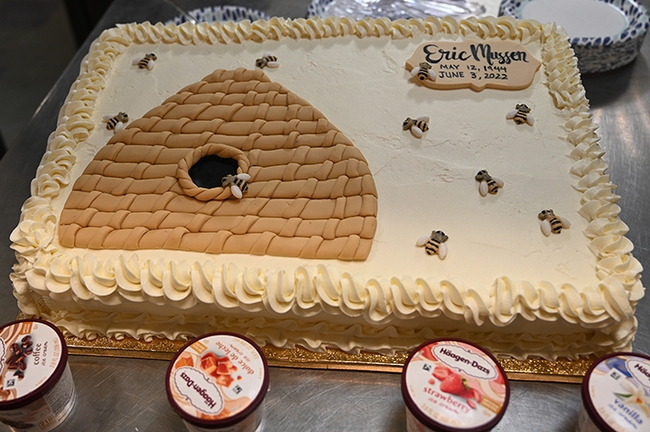
Adding to the celebration: a memory table from the Mussen family; bee pins to all the guests from the National Honey Board; a bee observation hive display from UC Extension apiculturist Elina Lastro Niño, director of the California Master Beekeeper Program (CAMPB), and Wendy Mather, program manager of CAMPB; honey straw donations from JoshuaZeldner, Amina Harris of Z Specialty Food, LLC; and ice cream donations from Haagen-Dazs (HD). Eric worked closely with HD especially during the colony collapse disorder phenomenon and the installation of the UC Davis Bee Haven on Bee Biology Road, UC Davis.
Olive and Vine of UC Davis catered the event. CreaTions N' Events of Sacramento provided a bee-themed cake, complete with a skep and honey bees.
"The world," said Dr. Leal, a former chair of the Department of Entomology who knew Eric well, "is a lesser place without Eric."
#EricStrong.
Eric is survived by his wife, Helen Mussen, sons Timothy Mussen (Noelle) of Rancho Cordova, and their children Amber and Alex; Christopher Mussen (Jacqueline Silva), of Davis; his younger brother Alan Mussen (Lynda) and their daughter, Allie and husband, Nick Arnold, all of Peru, N.Y.; and other relatives in New York and Michigan.
Memorial contributions may made to the California State 4-H Beekeeping Program, with a note, "Eric Mussen Memorial Fund." Checks may be be made out to:
California 4-H Foundation
Attn: Development Services (Eric Mussen Memorial Fund, California State 4-H Beekeeping Program)
2801 Second Street
Davis, CA 95618
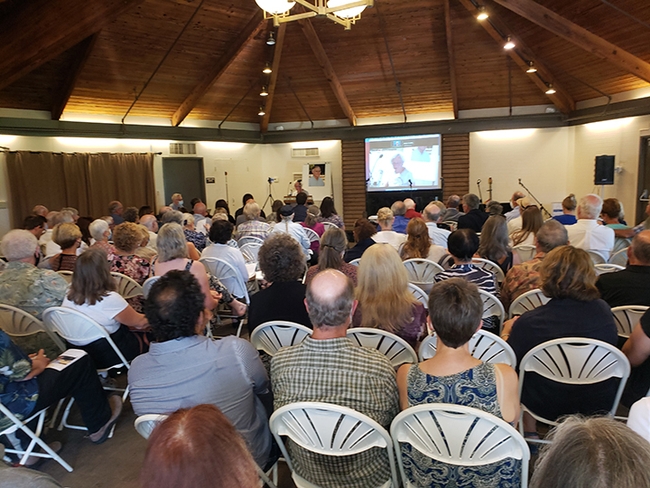
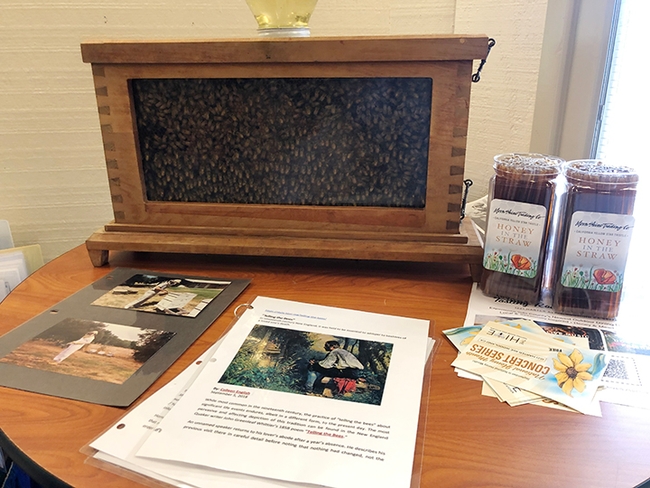
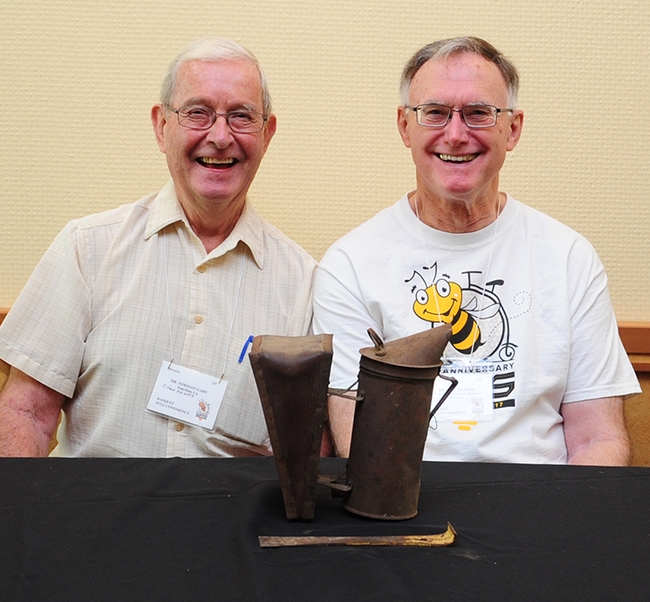
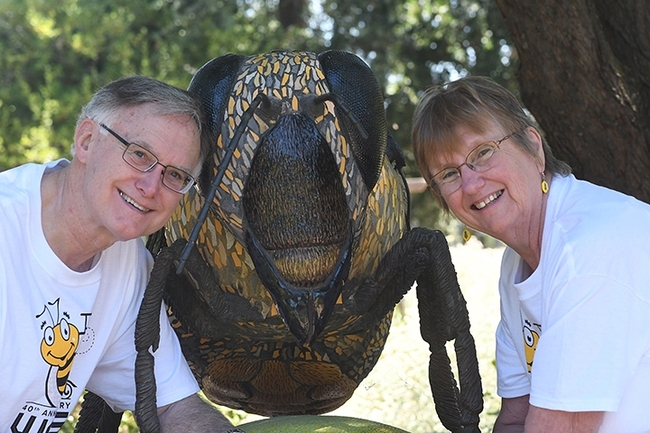
- Author: Kathy Keatley Garvey
Hello, Friday Fly Day!
It's time to post an image of syrphid fly, aka hover fly or flower fly.
We took this dorsal view of a syrphid fly in January of 2009.
This syrphid fly, probably as Syrphus opinator, was warming its flight muscles in the Ruth Risdon Storer Garden, part of the 100-acre UC Davis Arboretum and Public Garden. These flies are often mistaken for honey bees.
Interested in flower flies and their biological control roles? You'll want to read entomologist Robert Bugg's piece on "Flower Flies (Syrphidae) and Other Biological Control Agents for Aphids in Vegetable Crops" (Publication 8285, May 2008, University of California, Division of Agriculture and Natural Resources.) Bugg, who holds a doctorate in entomology from UC Davis, and his four co-authors illustrated the 25-page research article with photos that will help you recognize many of the syrphids.
At the time Bugg was a senior analyst, agricutural ecology, UC Sustainable Agriculture Research and Education Program, UC Davis. Perfect name for an entomologist, don't you think?
Happy Friday Fly Day!
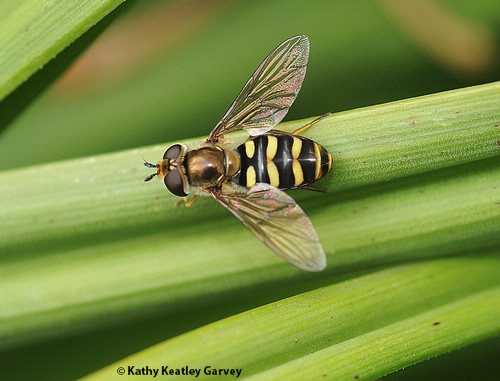
- Author: Kathy Keatley Garvey
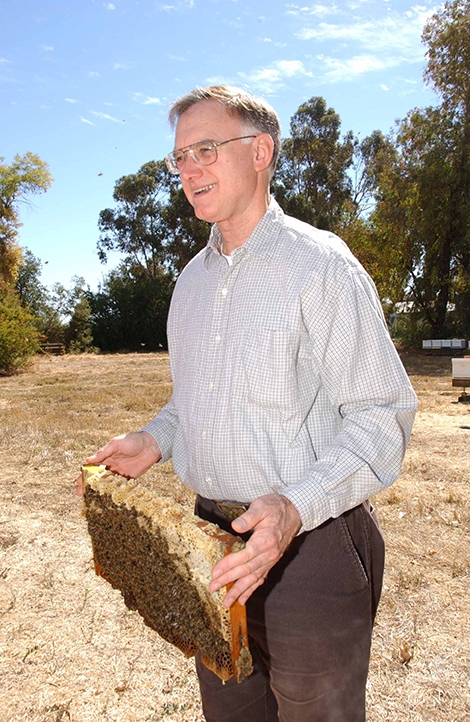
Wikipedia defines CCD as "an abnormal phenomenon that occurs when the majority of worker bees in a honey bee colony disappear, leaving behind a queen, plenty of food, and a few nurse bees to care for the remaining immature bees."
We were going through materials this week for the Celebration of Life and Legacy for UC Extension apiculturist Eric Mussen of the UC Davis Department of Entomology and Nematology, when we ran across his Oct. 9, 2007 presentation delivered as part of the UC Davis Department of Entomology's Distinguished Seminar Series.
We covered his seminar, which drew a capacity crowd and scores of questions. We still have his PowerPoint.
The news story bears repeating:
UC Davis honey bee specialist Eric Mussen fingered a line-up of prime suspects at his “BSI: The Case of the Disappearing Bees” lecture on Oct. 9, part of the UC Davis Department of Entomology's Distinguished Seminar Series.
Mussen identified malnutrition, parasitic mites, infectious microbes and insecticide contamination as among the possible culprits. It's a complex issue, he said, but one thing is certain: “It seems unlikely that we will find a specific, new and different reason for why bees are dying.”
Colony collapse disorder (CCD), a phenomenon where bees mysteriously abandon their hives, is not a new occurrence, said Mussen, the Extension Apiculturist at UC Davis since 1976.
“Similar phenomena have been observed since 1869,” he said. “It persisted in 1963, 1964 and 1965 and was called Spring Dwindling, Fall Collapse and Autumn Collapse. Then in 1975, it was called Disappearing Disease.”
“But the disease wasn't what was disappearing,” Mussen quipped. “The bees were."
Massive bee die-off also occurred during the winter of 2004-05, but only those who read bee journals knew about it, Mussen told the crowd in the campus Activities Recreation Center. The latest die-off caught the attention of the national media last fall when a Pennsylvania beekeeper asked researchers at Pennsylvania State University to look at samples of his dying bees in Pennsylvania and Florida. “The local media picked up the story and the rest is history, including yours truly on the Lehrer Hour.”
One-third of America's honey bees vanished this past year due to the mysterious CCD, characterized by almost total hive abandonment. Nearly all adult worker bees unexpectedly fly away from the hive, abandoning the stored honey, pollen, larvae and pupae. Usually they leave in less than a week, and only the queen and a few young workers remain, Mussen said.
Honey bees normally do not abandon their brood, he said. “Nurse bees” continually feed the young, which increase 1,000-fold in size in six days.
“That's like an 8-pound baby weighing 4 tons in six days,” Mussen said.
Mussen, who received the American Association of Professional Apiculturists' excellence award in January for his bee industry leadership and apicultural research publications, and was named the California State Beekeepers' Association's 2006 “Beekeeper of the Year” for his industry-wide contributions, finds the silence of the bees troubling.
“The real reason bees are important is that we rely on them for crop pollination,“ he said. Commercial honey bees pollinate about 90 of the country's crops, valued at $15 billion.
“One third of our U.S. diet depends on honey bees,” Mussen said. “If bees produce fruits and vegetables somewhere else, do we (Americans) want to be as dependent on food as we are on oil?”
Bees are especially crucial to California's 600,000 acres of almonds, he said. To pollinate the almonds, growers need 1.2 million bee hives, “but California doesn't have 1.2 million bee hives, so they have to be trucked here.”
That, he said, can add to the bee stress.
Mussen linked malnutrition as a key factor in CCD. Honey bee nutrition is “weather dependent,” he said. “The best-fed bees are the healthiest, while malnourished bees are less resistant.”
Malnutrition and climate-linked issues include: Did local weather events affect pollen-producing plants negatively?
- Was there a lack of bloom (nectar and pollen) due to lack of rain or too much heat?
- Was there reduced access to flowers due to excess rain?
- Did cold nights interfere with meiosis that led to “sterile” or “non-viable” pollens?
- Do these types of pollen contain the usual proteins, vitamins, minerals and lipids required by the bees?
Mussen said that many regions in the United States experienced significant drought in 2006. “The U.S. honey crop was off 11 percent, one of the lowest on record. The California crop was off 30 percent; North and South Dakota crops were off nearly 15 and 40 percent respectively.”
If there's malnutrition in August and September, that adversely affects the winter bees, he said. A mix of quality pollens is required to rear healthy winter bees.
Unlike the California definition based on amount of water in the reservoirs, the beekeepers' definition of drought is: Is there enough soil moisture to keep the flowers growing? "This year there was not,” Mussen said.
Malnourished bees are more susceptible to disease, predators and insecticides, he pointed out. The Varroa destructor mites, introduced here in 1987 from the Asian bee (Apis cerana), spread across the country in five years, killing the American bee (Apis mellifera), known as the European bee.
Compared to fruit flies and mosquitoes, “bees have a limited immune system; they're pretty anemic,” he said.
Another problem: “Varroa mites have become resistant to most legal chemical controls that used to keep them in check.”
Mussen cast suspicion on several viruses as CCD factors: the Kashmir bee virus, acute bee paralysis virus, deformed wing virus, black queen cell virus and the Israel acute paralysis virus.
“Honey bees have about 20 known viruses, most of which can cause disease,” he said. Some viruses remain latent, just like chicken pox in humans, which can show up as shingles later in life.
USDA scientists found the Israeli acute paralysis virus, in nearly all of the CCD colonies they tested, but none in the control group. In addition, they found the Kashmir bee virus in all the CCD colonies tested.
Also found in all the CCD colonies tested were the infectious microbes Nosea ceranae and Nosema apis. N. ceranae, a relatively new fungal disease of American honey bees, was imported from the Asian honey bee, Apis cerana. N. apis, its American counterpart, has been around for at least a century.
A favorite suspect among the beekeepers is neonicotinoids, chemicals designed to mimic the toxic effects of a neurotoxin from the tobacco family. The nicotine-like insecticide kills fleas on cats and dogs, and is used as a seed treatment and in side dressing and foliar spray applications.
“The insecticides enter various plant tissues and become distributed, systemically, throughout the plant,” he said. “Nicotine is so toxic to humans that if you put a drop of pure nicotine on your finger, you're dead.”
Neonicotinoids have been formulated to be nearly non-toxic to mammals, birds, and fish but remain extremely toxic to invertebrates.
Laboratory studies showed that miniscule doses of neonicotinoids increased the rate of learning in bees, but at high doses, bees failed to respond to training.
“It wasn't memory loss; it was intoxication,” Mussen said. “They were drunk.”
Another suspect: Gaucho® (imidacloprid), used as a seed treatment on sunflowers. Beekeepers claimed that when bees visited sunflowers, they never returned to their hives; “they lost their memory.” France and Spain banned imidacloprid, but “bees are still failing in their hives,” Mussen noted.
Mussen said no scientific documentation exists to blame imidacloprid for the bee die-off. A study found only 5 parts per billion maximum in the nectar of sunflowers and canola, he said. The Bayer fact sheet indicates that the insecticide is toxic to honey bees at 192 ppb.
Among the more “quirky” explanations for CCD: cell phone usage, alien encounters, honey bee “rapture” (where hive populations “ascend to that big honeycomb in the sky en masse”); and chemtrails, aircraft-released vapors.
“Some thought chemtrails was a military-industrial complex plan to kill all children and old people — and got the bees and birds by mistake,” Mussen said.
Mussen said he hopes that the current fascination with honey bees will lead to more research and more research funding. (End of story)
(Editor's Note: Dr. Mussen, a 38-year California Cooperative Extension apiculturist and an invaluable member of the UC Davis Department of Entomology and Nematology faculty, died Friday, June 3 at his home in Davis. He was 78. Attendance to the UC Davis-sponsored event celebrating his life and legacy is closed, but UC Davis distinguished professor Walter Leal will live-stream the event on Zoom. It will be permanently housed on YouTube. Registration for the Zoom webinar is underway at https://bit.ly/3dIyAhG. The YouTube account is at https://youtu.be/Kj5NuQ_rBuo. The webinar starts at 4 p.m. on Sunday. Aug. 28.)
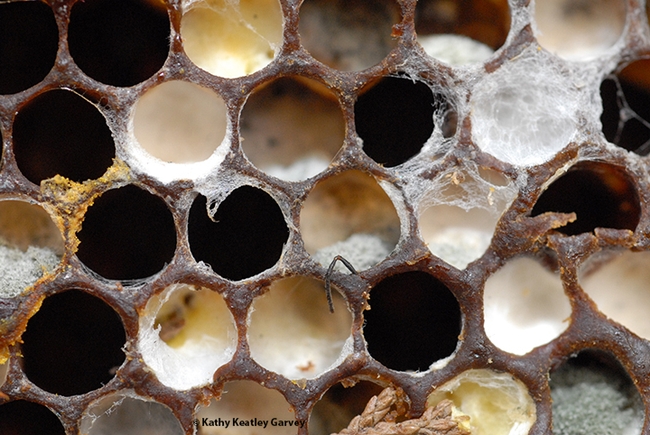
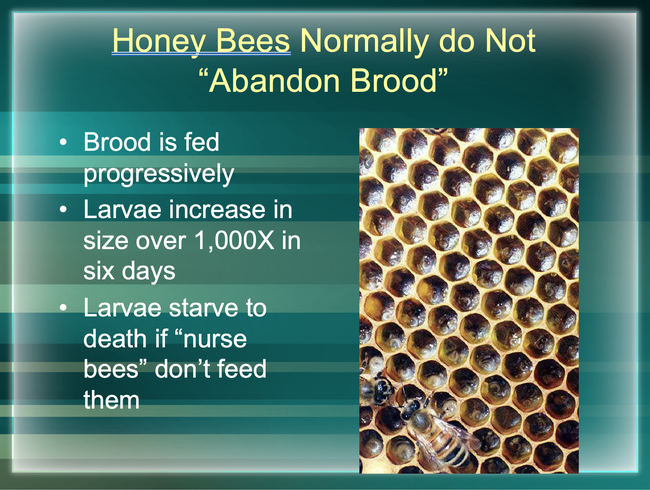
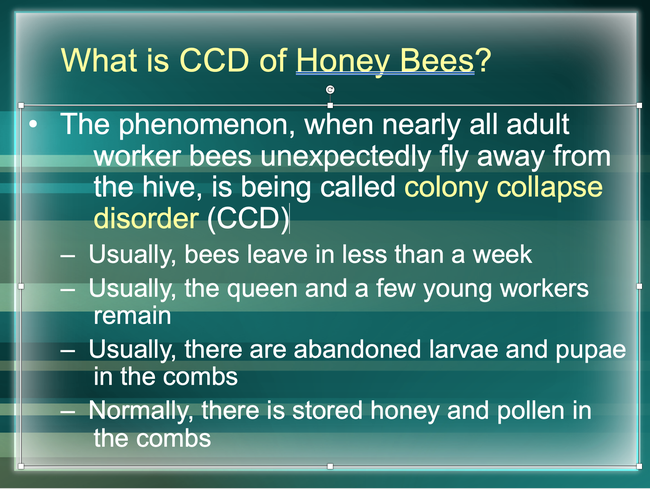
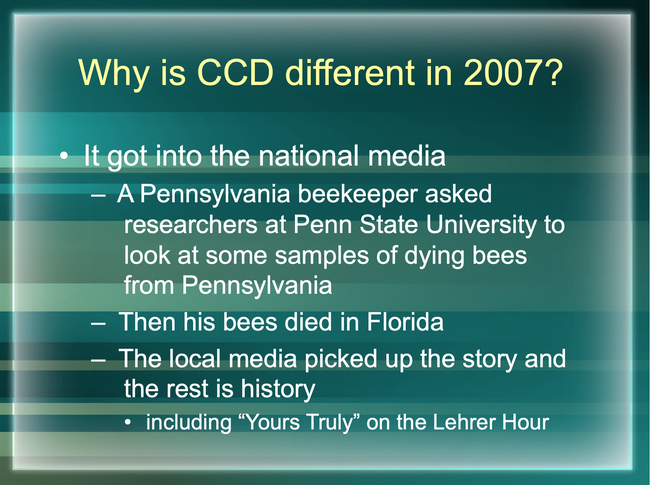
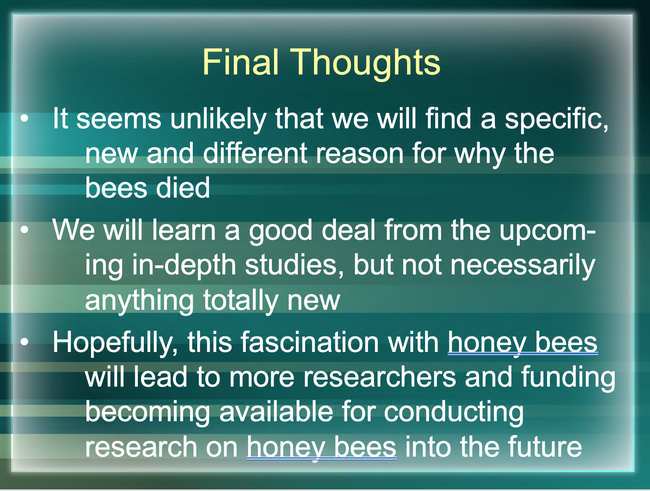
- Author: Kathy Keatley Garvey
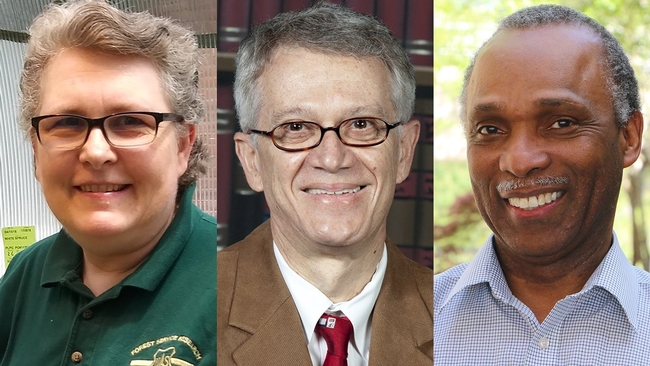
Leal and Simmons, the "twin brothers," co-chaired the 2016 International Congress of Entomology conference, “Entomology Without Borders,” held in Orlando, Florida, that drew nearly 7000 attendees from 101 countries. It was the largest gathering of entomologists in the history of insect science.
"Honorary Member" is the highest award offered by the 7000-member ESA. The recipients must have "served ESA for at least 20 years through significant involvement in the affairs of the society that has reached an extraordinary level,” ESA officials said in announcing the three recipients today (Aug. 24). “Candidates for this honor are selected by the ESA Governing Board and then voted on by the ESA membership.”
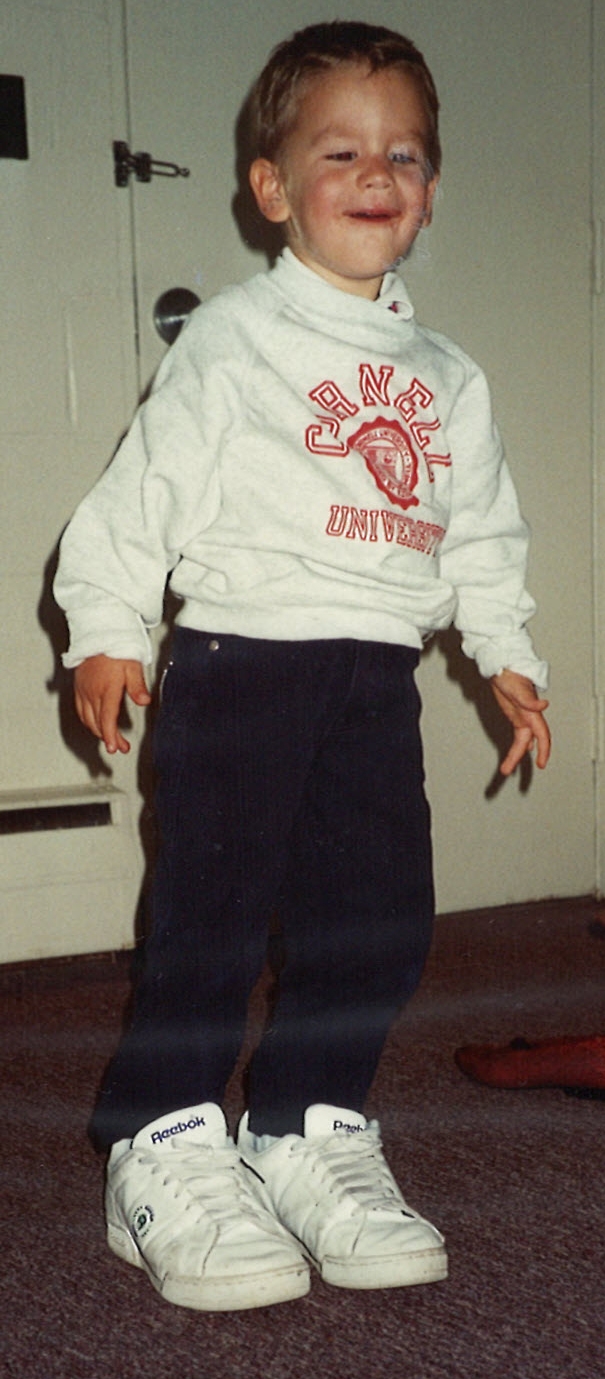
Keena's UC Davis connections: she received three UC Davis degrees in entomology: her bachelor's degree in 1983; her master's in 1985, and her doctorate in 1988. (See her website.)
The trio will be recognized during the 2022 Joint Annual Meeting of the Entomological Societies of America, Canada, and British Columbia, Nov. 13-16, in Vancouver.
Leal is the sixth UC Davis faculty member to be named an Honorary Member of ESA. UC Davis distinguished professor Frank Zalom of the UC Davis Department of Entomology and Nematology and the 2014 president of ESA, achieved the honor in 2021. Professor W. Harry Lange (1912-2004) received the award in 1990; Professor Donald MacLean (1928-2014), the 1984 ESA president, won the award in 1993; Professor Bruce Eldridge in 1996, and Professor John Edman in 2001.
Leal, an expert in insect communication, investigates how insects detect odors, connect and communicate within their species; and detect host and non-host plant matter. His research, spanning three decades, targets insects that carry mosquito-borne diseases as well as agricultural pests that damage and destroy crops. He and his lab drew international attention with their discovery of the mode of action of DEET, the gold standard of insect repellents.
Leal was recently elected chair of the International Congress of Entomology Council, which selects a country to host the congress every four years and which supports the continuity of the international congresses of entomology. Leal succeeds prominent entomologist May Berenbaum of the University of Illinois, Urbana-Champaign, editor-in-chief of the journal, Proceedings of the National Academy of Sciences and a 2014 recipient of the National Medal of Science.
“I have big shoes to fill,” he said. (See news story)
As a leading global scientist and inventor in the field of insect olfaction and communication, Leal was named a 2019 Fellow of the National Academy of Inventors (NAI) for his impact in the fields of molecular, cellular biology, and entomology.
Highly honored by his peers, Leal is an Honorary Fellow of the Royal Entomological Society (2015) and Fellow of the American Association for the Advancement of Science (2005), ESA (2009), and California Academy of Sciences (2015). He received both the Medal of Achievement (1995) and the Medal of Science (2008) from the Entomological Society of Brazil and the 1998 Gakkaisho from the Japanese Society of Applied Entomology and Zoology. In 2019, ESA selected him to deliver the Founders' Memorial Lecture on "Tom Eisner: An Incorrigible Entomophile and Innovator Par Excellence."
The International Society of Chemical Ecology honored him with its Silverstein-Simeone Award (2007) and the Silver Medal (2012). In 2012, Leal was elected to the Brazilian Academy of Science (inducted in 2013). For his creativity in entomology, Leal received ESA's Nan Yao Su Award (2011) and was elected a Fellow of the National Academy of Inventors (2019). The UC Davis Academic Senate awarded him both the Distinguished Teaching Award (2020) and the Distinguished Scholarly Public Service Award (2022).
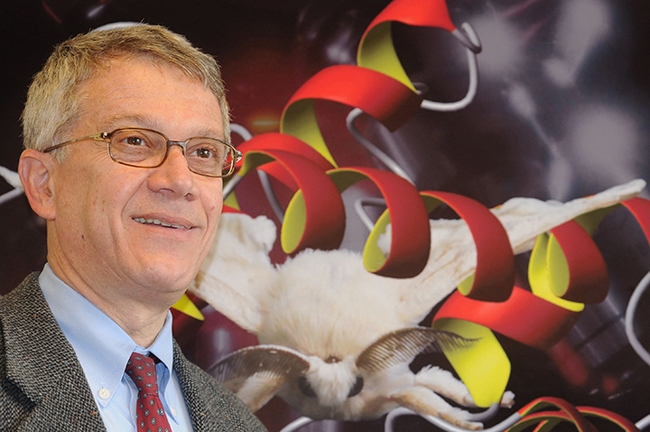
- Author: Kathy Keatley Garvey

The 2023 International Western Monarch Summit will take place Friday through Sunday, Jan. 20-22 at Pismo Beach, San Luis Obispo, and registration is now underway.
It's a place to learn, to share and to serve.
It's sponsored by Western Monarch Advocates (WMA), which relates its mission is "to serve as an overarching entity to encourage and facilitate communication and interaction of groups and individuals committed to restoring the western monarch butterfly population-regardless of their affiliation or location--in the hope that the shared knowledge will empower each of them to improve and better achieve restoration goals within their own respective affiliation or location."
WMA's co-chair and founder is former adjunct professor Robert Coffan of Southern Oregon University, who is also the co-founder of the Southern Oregon Monarch Advocates and advisor for the Pollinator Project Rogue Valley.
Among the speakers at the monarch summit will be entomologist David James, an associate professor at Washington State University (and a WMA board member) who researches migratory monarchs. He maintains a Facebook page on Monarch Butterflies in the Pacific Northwest (PNW), a portal for monarch butterfly research, conservation and news in the PNW.
"David developed a passion for entomology at the age of 8 in England by rearing caterpillars in his bedroom," the website indicates. "He studied zoology at the University of Salford, UK, then migrated to Australia to work for the New South Wales Department of Agriculture in Sydney researching agricultural pests and their management. A PhD on the winter biology of monarch butterflies in Sydney and a career as a biocontrol and conservation biology scientist in Australia and the U.S. followed. Since 1999, David has been a professor in entomology at Washington State University. David has published more than 250 peer-reviewed scientific papers, extension articles and books and co-authored life histories of Cascadia Butterflies, which was pronounced ‘magisterial' by Sir David Attenborough."
Other scientists speaking at the summit will include Ryan Norris, University of Guelph, Canada; Ek del-Val of IIES-UNAM (Instituto de Investigaciones en Ecosistemas y Sustentabiliad or Ecosystems Research Institute and Sustainability, Mexico; and Myron Zalucki, professor emeritus, University of Queensland, Australia.
The event will include networking, field trips to the overwintering monarch groves, and meals, or as the website indicates, a place..."to come together near our overwintering monarchs for a few days to interact, learn, smile a bit, and most importantly, be more empowered than ever to help restore our western monarch population. Come and join us at the 2023 International Western Monarch Summit!"
Meanwhile, we're waiting for those migratory monarchs from the Pacific Northwest to flutter through our garden on their way to a coastal California overwintering site, as they have in past years.
"It is mid-August, and the Monarch Fall Migration has begun in the PNW," James wrote on the Facebook page. "It starts in the first week of August and reaches a crescendo in the last week of August and the first week of September, at least for WA and ID. A little later in Oregon. Most Monarchs eclosing in the PNW from now until October, will become part of the long-lived (up to 10 months) migratory generation. And there are many Monarchs eclosing now! In the first 2 weeks of August, there have been almost as many sightings of Monarchs in the PNW (153) as there were during the 4 weeks of July (166). There appears to be at least 10 times the number of Monarchs in the PNW this summer as was reported last summer. To date, heat and fires have not been excessive in most areas and I am optimistic we will see a strong migration over the next six weeks. Unless excessive heat intervenes (particularly in CA in September), I am expecting overall overwintering populations to be comparable or greater than last winter. Northerly overwintering sites (from Santa Cruz northwards) should see much larger populations than last winter. Please continue reporting the Monarchs you see and watch out for pristine-looking migrants refueling from your fall garden nectar."
We first connected with Professor James when one of his citizen scientists, Steve Anderson in Ashland, Ore., tagged a male monarch on Aug. 28, 2016 that proved quite the traveler. It stopped to fuel up on nectar in our Vacaville pollinator garden for at least five hours on Sept. 5, 2016. I managed to photograph the monarch. The tag flashed "WSU," an abbreviation of my alma mater, Washington State University. It read “Monarch@wsu.edu A6093." (See Bug Squad blog and WSU news story)
"So, assuming it didn't travel much on the day you saw it, it flew 285 miles in 7 days or about 40.7 miles per day," James related. "Pretty amazing. So, I doubt he broke his journey for much more than the five hours you watched him--he could be 100 miles further south by now."
Maybe we'll see more monarchs traveling through Vacaville this fall.
Related Links:
- David James' Incredible Research on Migratory Monarchs (June 5, 2018, Bug Squad)
- Western Monarch Population Increase: What Does This Mean? (Dec. 10, 2021, Bug Squad)
